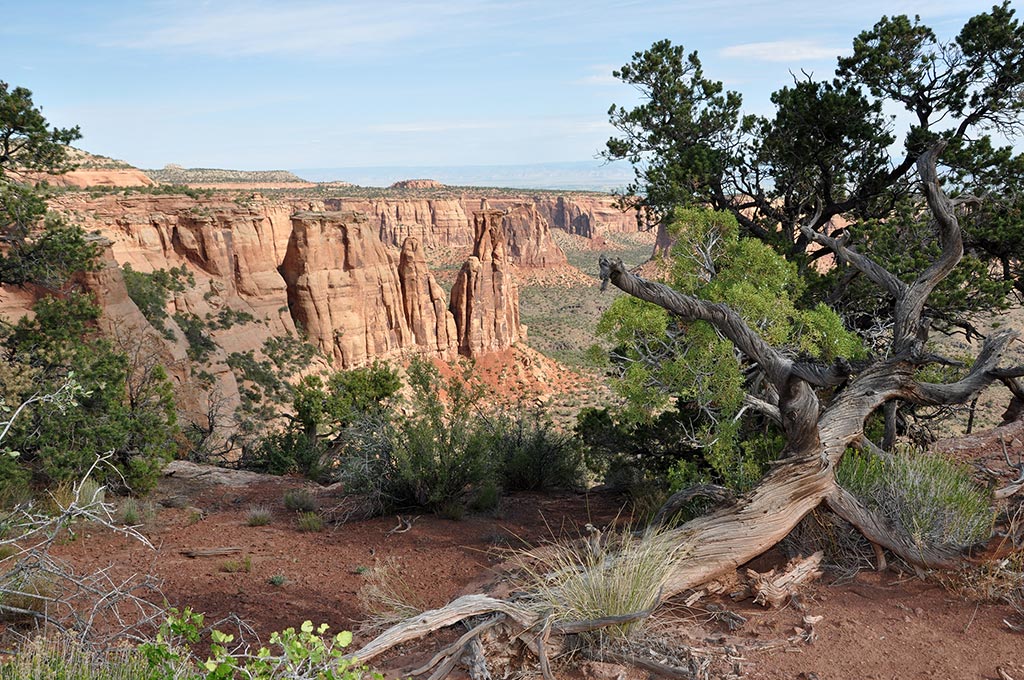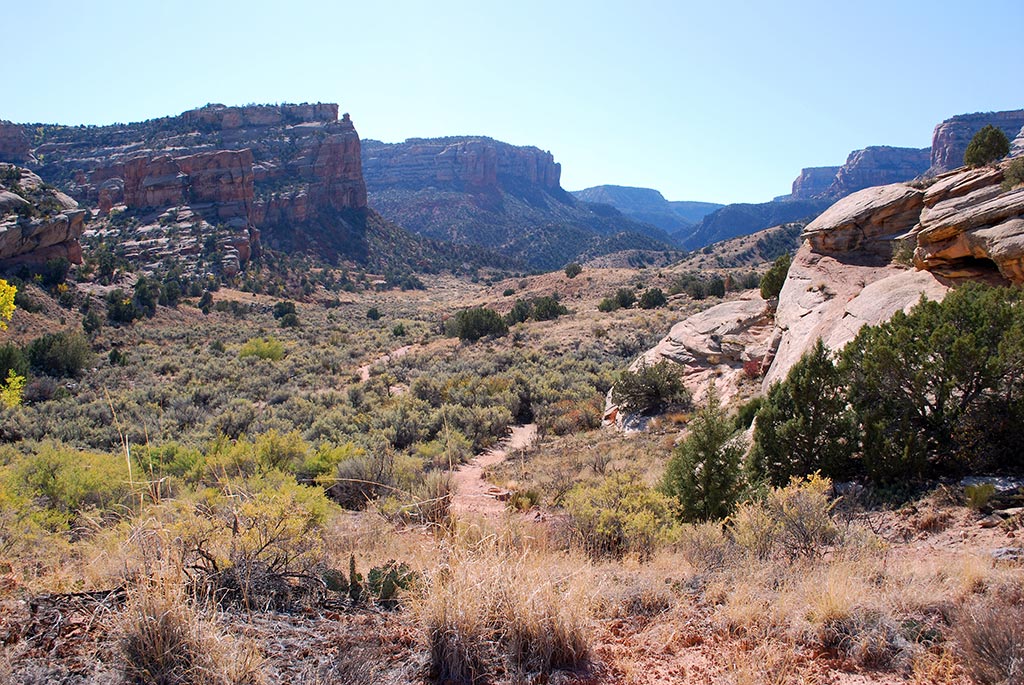Located high on the greater Colorado Plateau, Colorado National Monument features steep red rock canyons, towering monoliths and sprawling pinyon-juniper woodlands. It is also home to desert bighorn sheep, mountain lions and coyotes, among other critters. In 1911, President Taft designated the monument, noting that “extraordinary examples of erosion are of great scientific interest,” in his presidential proclamation. Scientists still conduct research in the park today, and visitors explore the red rock landscape in all sorts of ways—from camping and backpacking to hiking, biking and rock climbing.

Monument Canyon includes views of rock formations like the Kissing Couple. (Photo Credit: National Park Service)
Colorado National Monument, near Grand Junction and the western edge of the state, is one of more than 100 national monuments. Like national parks, many of these monuments offer stellar opportunities for hiking, camping and other outdoor recreation, though they differ from national parks and other public lands. Typically, national monuments are smaller than national parks. A variety of federal agencies can manage national monuments; only the National Park Service oversees national parks. The president or Congress can designate national monuments for cultural, historical or scientific reasons; national parks are typically designated for other reasons, such as their scenic or educational value. National monuments also tend to be less crowded than national parks. Last year, Colorado National Monument saw more than 375,000 visitors, a fraction of the 4.4 million who visited Rocky Mountain National Park the same year.
What do those 375,000 people do when they come to the monument, which spans some 20,000 acres? Everything from enjoying a scenic drive to testing their mettle on a 33-mile biking loop with sheer drop-offs and 2,300 feet of elevation gain.
Hiking in Colorado National Monument
The monument contains more than 40 miles of hiking trails, encompassing a variety of short hikes and longer trails. Some are quick jaunts from the car and others are longer, more involved explorations.
“If folks are looking for a particular experience in the monument, stop by the visitors’ center and we would be happy to help them pinpoint the type of hike that will suit their purposes,” says monument Chief of Interpretation Arlene Jackson. “One of the things I love about this place is even though it’s not very big, it seems to have a little something for everyone.” Below are a few visitor favorites.
Monument Canyon Trail
- Length: 5.8 miles (one-way)
- Difficulty Rating: Intermediate
- Best For: Wildlife watchers
With stunning views of rock formations like Independence Monument and Kissing Couple, Monument Canyon is one of the monument’s most scenic trails. The upper trailhead descends into Monument Canyon and the elevation change from the upper to the lower trailhead is substantial. It goes from 6,140 feet down to 4,700 feet, so be prepared for a change in elevation and incredible red rock scenery. The canyon is a good place to see bighorn sheep. It also contains an ample dose of history. “One of the cool things about the hike is you are hiking in the footsteps of people who have hiked this for 100 years,” Jackson says. She notes that John Otto, a key advocate for the creation of Colorado National Monument, was responsible for laying the trail and developing many of the rock cuts still seen today.
Window Rock Trail
- Length: 0.3 miles (round-trip)
- Difficulty Rating: Easy/intermediate
- Best For: Sweeping views
One of the shortest hikes in the monument, Window Rock is also one of the most spectacular. This mesa-top trail departs near the Saddlehorn Campground and winds along with top-notch views of Independence Monument, Wedding and Monument Canyons and dramatic monoliths. At the top, look down from the railing to see the rock “window.” “You are a ways up off the valley floor, so it can be a little scary for folks a little afraid of heights,” Jackson says. The route offers fascinating insight into geology and local plant life and a brochure is available to provide more detailed information.
Otto’s Trail
- Length: 0.4 miles (one-way)
- Difficulty Rating: Easy
- Best For: Photographers
This trail, named after John Otto, goes through pinyon-juniper woodlands and leads to views of monoliths like Pipe Organ, Praying Hands, Sentinel Spire and Independence Monument. It also provides an excellent overview of the monument’s canyons. “It’s a short hike but gives you this stunning view of our major canyons here in the monument,” Jackson says. You’ll likely have your head on a swivel because this short trail offers endless opportunities for photography.
Cycling in Colorado National Monument
Rim Rock Drive is the monument’s iconic and historic, yet treacherous road. In the 1930s, the Civilian Conservation Corps played a large role in building the road, mainly with hand tools, and the same winding and steep road takes visitors through the monument today. Cyclists and motorists often explore this 23-mile-long route, sharing narrow lanes that sometimes have precipitous drop-offs. The reward: stunning views of red rock canyons, sandstone columns, evergreen junipers, pinyon pines and more. Pullouts provide great spots for photography.
Cyclists must comply with a number of rules, including riding single file and having lights that meet specific requirements in tunnels, so be sure to brush up on the rules before setting out on a bike. Many cyclists make a “grand loop” of 33 miles (with 2,300 feet of elevation gain) on a longer route that includes a few roads outside the monument as well.
People looking for a shorter bike ride can simply cycle on the roads up on top of the mesa. Only road biking is allowed in the monument, so cyclists are required to stick to the roads.
Camping and Backpacking in Colorado National Monument
Why go home at the end of the day when you can lay your head at the Saddlehorn Campground instead? The monument’s only campground has some sites that can be reserved in advance, while others are first come, first served. It is open year-round.
Backcountry camping is also available and a free permit, available at the visitor center, is required. Monument staff remind people to bring plenty of water since high levels of selenium and other harmful substances make backcountry water sources undrinkable.

Photo Credit: National Park Service
Climbing in Colorado National Monument
Wingate and Entrada sandstone lure experienced rock climbers to explore a number of crags and towers in the monument, including the 400-foot-tall Independence Monument. “Most of the people who visit the monument come to do towers,” says Jesse Zacher, President of the Western Colorado Climbers’ Coalition. “The most popular tower is of course Otto’s Route up Independence Monument.” Back in the early 1900s, John Otto would climb the tower every Fourth of July to post an American flag on top. According to Jackson, Mesa County’s search and rescue team still keeps the tradition alive, climbing the route each Independence Day to post the flag, and then returning a week or so later to retrieve it.
“Other popular towers are Sentinel Spire and Kissing Couple,” Zacher says. “These towers require more skill but are well worth the effort.”
Most routes in the monument are for trad climbing, and a number of regulations apply. Several guide services are licensed to operate in the monument.
Tips for Visiting Colorado National Monument
Visiting Colorado National Monument is possible year-round, though the road closes when conditions are poor. Summer temperatures can reach 100 degrees Fahrenheit, and thunderstorms are common. “The summer is incredibly hot—it can get up to 100 degrees,” says Jackson. “Because all of our trees are pinyon-juniper trees, which are reasonably short trees, there is not a whole lot of shade.”

Photo Credit: National Park Service
Winter can be snowy and icy, with high temperatures ranging from 10 to 45 degrees Fahrenheit; temperatures are typically more moderate in the spring and fall.
Also be aware of possible road construction. A construction project is scheduled to cause minor traffic delays through the end of July 2018.
However a visitor chooses to enjoy Colorado National Monument, the site’s red rocks, canyons and endless skies are bound to leave an impression.


